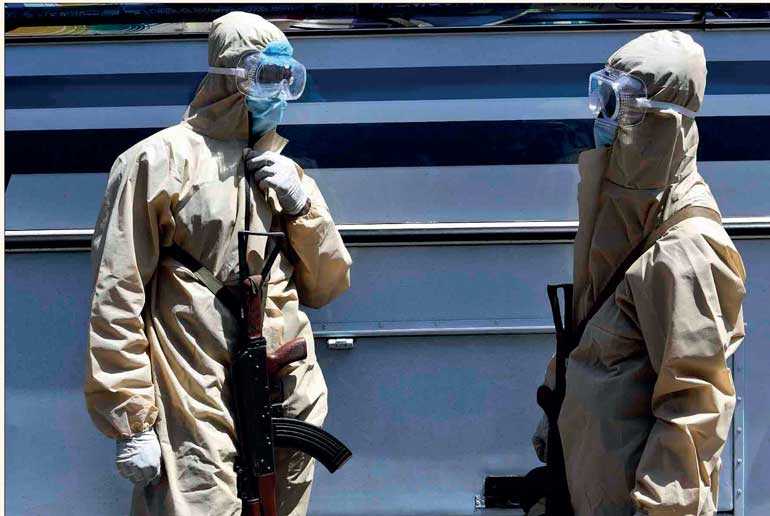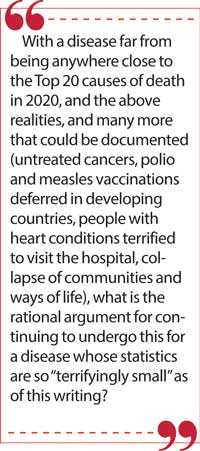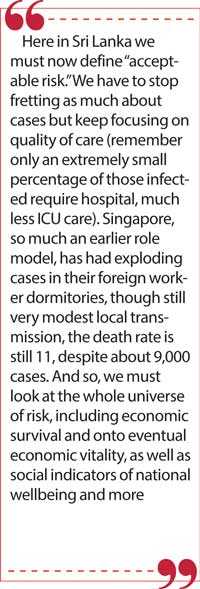Tuesday Nov 04, 2025
Tuesday Nov 04, 2025
Friday, 24 April 2020 00:00 - - {{hitsCtrl.values.hits}}

There have been 177,000 coronavirus deaths as I write, globally. Normally, through all the causes of mortality, 15 million people die in the first three months of the calendar year. That is 1.18% added to  normal mortality globally, and that’s with my taking the annual count of the normal mortality figures only to end March, while the coronavirus number is accurate as of 22 April. So, we’ve given it an extra three weeks.
normal mortality globally, and that’s with my taking the annual count of the normal mortality figures only to end March, while the coronavirus number is accurate as of 22 April. So, we’ve given it an extra three weeks.
And the 177,000 may not be right, as we have controversies as to how cases that were “probably COVID-19” or had other contributing factors in which COVID-19 played a part but not the main cause of death, are showing up on death certificates. But even taking the numbers as accurate, please take a good, unvarnished look at it.
Quick UN Summary
And then let’s read some excerpts from this UN risk assessment report:
“Hundreds of thousands of children could die this year due to the global economic downturn sparked by the coronavirus pandemic and tens of millions more could fall into extreme poverty as a result of the crisis, the United Nations warned on Thursday.”
The world body also said in a risk report that nearly 369 million children across 143 countries who normally rely on school meals for a reliable source of daily nutrition have now been forced to look elsewhere.
Compared with adults, children infected with the coronavirus are less likely to have symptoms and more likely to have a mild illness, and virtually no fatalities, US and Chinese studies have found. But the UN report warned that “Economic hardship experienced by families as a result of the global economic downturn could result in hundreds of thousands of additional child deaths in 2020, reversing the last two to three years of progress in reducing infant mortality within a single year.”
With businesses shut down and more than a billion people told to stay home to avoid spreading the virus, the International Monetary Fund has predicted the world would this year suffer its steepest downturn since the Great Depression of the 1930s. The United Nations said an estimated 42 million to 66 million children could fall into extreme poverty as a result of the coronavirus crisis this year, adding to the estimated 386 million children already in extreme poverty in 2019.
The UN report on children also said 188 countries have imposed countrywide school closures, affecting more than 1.5 billion children.
“The potential losses that may accrue in learning for today’s young generation, and for the development of their human capital, are hard to fathom,” it said. “More than two-thirds of countries have introduced a national distance learning platform, but among low-income countries the share is only 30%.”
Please explain
So, I am open to hearing the answers to ANY of the following questions, therefore.
With a disease far from being anywhere close to the Top 20 causes of death in 2020, and the above realities, and many more that could be documented (untreated cancers, polio and measles vaccinations deferred in developing countries, people with heart conditions terrified to visit the hospital, collapse of communities and ways of life), what is the rational argument for continuing to undergo this for a disease whose statistics are so “terrifyingly small” as of this writing? 
The WHO, pandemic broadcasting central, might explain to us how to reconcile the sheer unmitigated lockdown mania (rather than selective quarantining, selective isolation, massive greater testing, and social distancing for some time) with its own data on annual influenza: “The World Health Organization estimates that worldwide, annual influenza epidemics result in about three to five million cases of severe illness and about 250,000 to 500,000 deaths.”
So, if there have been influenza seasons with 500,000 deaths, and we never shut down the planet, and the lower end is higher than the COVID deaths to date, even if there has been no over-reporting, what is the rationale this time?
Agreed, the infectiousness of COVID-19 is far greater, but it’s lethality as shown by global numbers is anything but horrifying as shown above. And surely the mortality rate is what we are primarily interested in.
Next question, what would indicate it is time to “relax” a lockdown regime (again note Sri Lanka has the only month-long 24-hour curfew among 195 countries, and there are countries that have functioning economies that have lower fatality rates, and some of them comparable caseloads, which I will argue we anyway need to lose our terror of)?
If the answer is “flattening the curve,” how flat? And if there is a spike, as “locked down” people head out into the world, either immediately, or in the Fall, we shut down again, for something that doesn’t even to date have the mortality of bad influenza?
For all the “lockdown merchants” could they explain their panacea for poverty, mass starvation, large-scale destruction of livelihoods? Because if they don’t have one, could they please shut the proverbial hell up? You cannot sanely advocate a policy tantamount to “suicide” as an option to be argued for. You simply CANNOT make an intelligible proposal with no cost-benefit assessment. Imagine if you fell and badly scraped your leg, with a danger of infection. And the “solution” was they amputated your leg, threw you out of your house to pay for the amputation, and said, “You’re cured!”
Back to Lanka
We have on the horizon, as per what we’ve most recently been told, a partial lifting of our rather curious curfew.
Let me put the same question here to any critics of this, “What is now, knowing what we know, the stated rationale for not lifting the curfew and letting normal life resume with social distancing, with testing, with targeted quarantining and targeted isolation of individuals or small groups or even a small area if necessary?”
By the way, any response has to, at the same time, offer some way of dealing with the following if we don’t resume increasingly normal economic life: complete potential crashing of the economy, escalating bankruptcies, erosion of supply chains, more devastation to export sector, further devaluation of the  currency, skyrocketing inflation, credit rating plunge, spikes in domestic violence, non-COVID medical care not being given, starvation for daily wage earners, smuggling, illicit liquor production and drug use, and more…
currency, skyrocketing inflation, credit rating plunge, spikes in domestic violence, non-COVID medical care not being given, starvation for daily wage earners, smuggling, illicit liquor production and drug use, and more…
The above are not “theoretical” they’ve already been happening and will mount.
One answer: This is “life and death.” No, not true. 12,000 monthly deaths in Lanka approximately each month. There is therefore no existing trigger point to raise that alarm. If cases multiplied 10 times to 3,000 as we’ve pointed out, and even at the possibly “inflated” global mortality rate, that’s 180 deaths. Each one we would of course experience as tragic and to be mourned and we would I know with our dedicated medical stars do our utmost to beat those stats, and I’m confident we would. But if we didn’t, and we got 180, that’s just a little over 1% addition to our normal mortality. Against that, is the literal destruction of our economic functioning without which we can provide no one any healthcare.
So, could we not support the President’s aim of returning us, carefully, to normal life? Many august economic bodies are presenting an economic plan which is laudable. But all of that is premised on the resumption of normal life, phased if necessary, with precautions for sure, but decisively and consistently.
But can we first celebrate and congratulate and affirm the President’s original instincts stated in March that this is not a country that cowers in crisis, and which now having managed this period and learned its lessons we trust, will not mortgage its future, its economic viability, it’s children’s education and their future, to some “phantom plague” that has not materialised despite all the media hysteria.
And is there one medical expert anywhere who can answer the European virologists who have published papers saying we need to get out into sunshine and fresh air, both of which, are destructive to viruses, are a boon to our immune systems, and will help us recover? Yes, with social distancing, yes with policing if need be, but we need to get out there and let Mother Nature do its natural cyclical healing, as happens otherwise in every flu and influenza season! Mr. President, urge us to take nature’s cure, responsibly and carefully, as adding to the wisdom we heard from our mothers is a chorus of esteemed global doctors who assure us, she won’t let us down.
Please keep 3 distinctions in mind Virtually all deaths are above
Virtually all deaths are above 65 globally. So, if there’s a post lock-down “surge” or a dreaded “second wave,” we isolate and protect the elderly, particularly with pre-existing conditions. With virtually no mortality risk otherwise let everyone else “protect” the elderly by keeping the economy going and growing around them, and to safeguard a future for their children and grandchildren.
More and more studies, including one just out by Stanford last week, are showing that far more people were infected globally than we knew, were asymptomatic and have antibodies. Therefore, this has likely been circulating for some time. So, we must stop our manic fascination with “cases” as that is therefore partially irrelevant (“relevant” to isolate, treat, test absolutely!) but not relevant to whether we run our economy and save millions of lives and/or livelihoods that way…which again, we simply cannot afford not to do. It is not a CHOICE, unless we have a treasury tucked away somewhere that can run the  country, service our debts, and keep our strategic sectors healthy, indefinitely while we chase the sheer fiction of “COVID eradication.” Oh, and we had then best keep our borders closed for years as well then too.
country, service our debts, and keep our strategic sectors healthy, indefinitely while we chase the sheer fiction of “COVID eradication.” Oh, and we had then best keep our borders closed for years as well then too.
Even the UK, looking back at its data, reports 50% reduction in infections occurred on March 16th when hand washing and social distancing were introduced, pre lockdown. Sweden, social distancing practiced, but fully open economy. Deaths are 15 per 100,000 compared with 24 per 100,000 in fully locked down (though still not curfewed) England. Less than 6% of the Swedish economy has filed for unemployment, a quarter of Britons (1.4 million people) have. Sweden’s story is still being written for sure, but that it’s still open (bars, restaurants, schools, with social distancing), and the results are where they are demonstrate the need to have a critical cost-benefit discussion and define “acceptable risk.”
So, here in Sri Lanka we must now define “acceptable risk.” We have to stop fretting as much about cases but keep focusing on quality of care (remember only an extremely small percentage of those infected require hospital, much less ICU care). Singapore, so much an earlier role model, has had exploding cases in their foreign worker dormitories, though still very modest local transmission, the death rate is still 11, despite about 9,000 cases.
And so, we must look at the whole universe of risk, including economic survival and onto eventual economic vitality, as well as social indicators of national wellbeing and more.
There cannot be a debate about “whether” to open up unless those who wish to have the debate can assure us they have any medical basis, globally benchmarked for a “curfew” as opposed to differing degrees of lockdown premised on evidence based thresholds or have an economic panacea that allows us to even consider “affording” to indulge their largely fact-free preferences. If they have neither, then perhaps they can join the ranks of those who pound makeshift pulpits in London’s Hyde Park, doubtless we can find them an equivalent quorum locally, and they can enjoy the intoxication of their own rhetoric without destroying others’ lives.
Let’s move
Let us lead the recovery regionally, from here in Sri Lanka.
We can stay medically prudent, but galvanise a return to life, and realise “risk-free” living doesn’t exist (cross a road, endure the stress of a large city, get on an airplane, work on a construction site, go paragliding). We can realise the world is starting to open up and some parts never shut and have some of the lowest fatalities in the world (Hong Kong, Taiwan, Vietnam), some reversed spikes and are flourishing now (South Korea), and many of these with large, teeming cities too. We can challenge ourselves to learn their lessons going forward and create our own customised responses as well.
But it’s high time for this perspective, time for courage, time for increasingly targeted interventions, high time to come together to revive Sri Lanka.